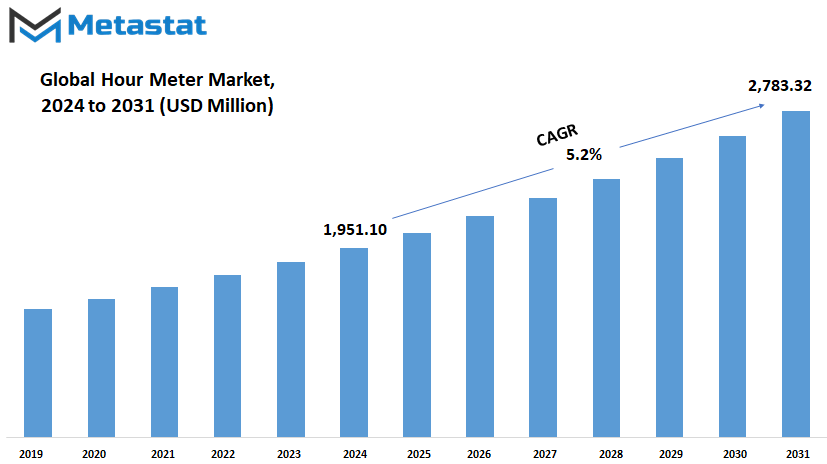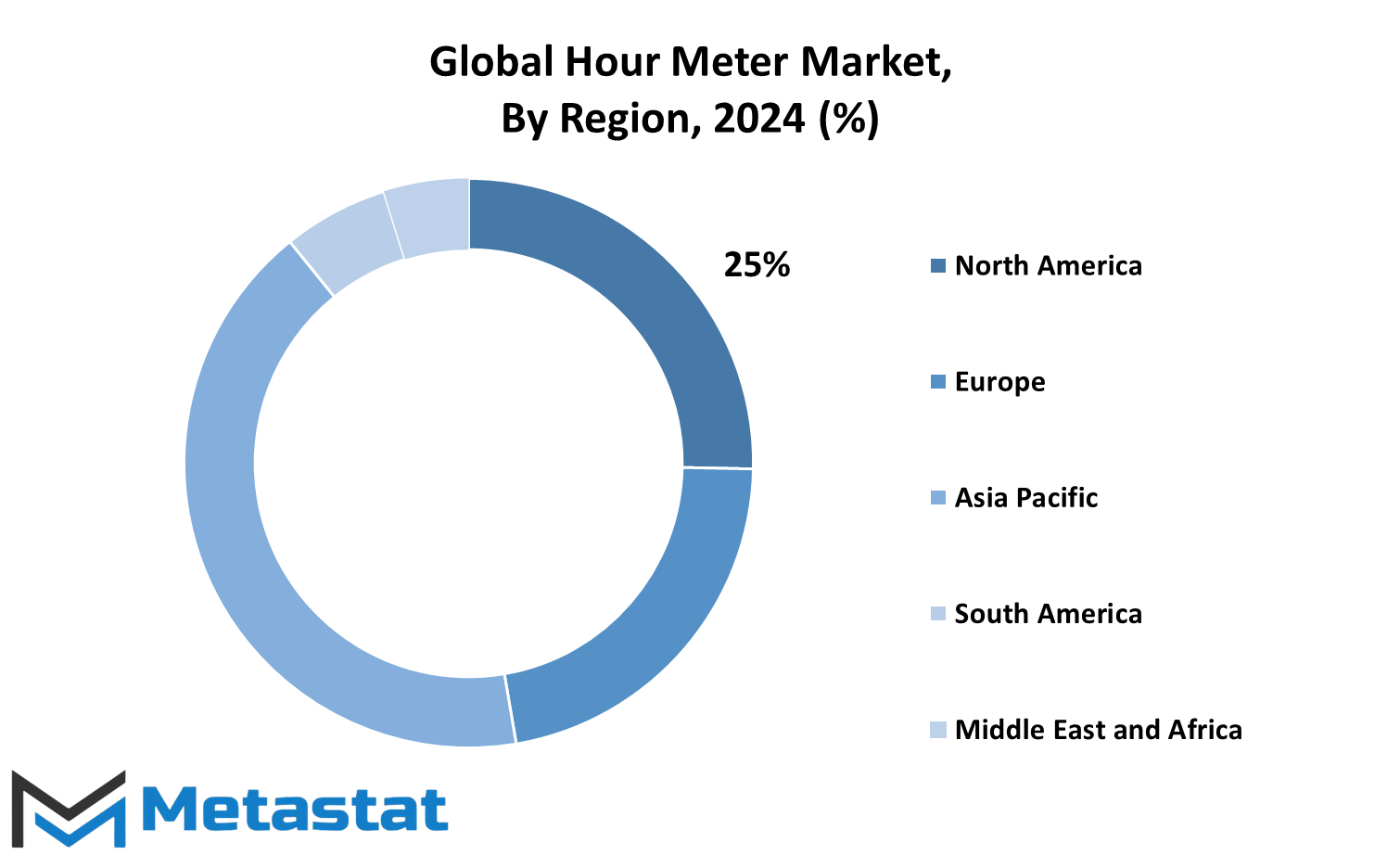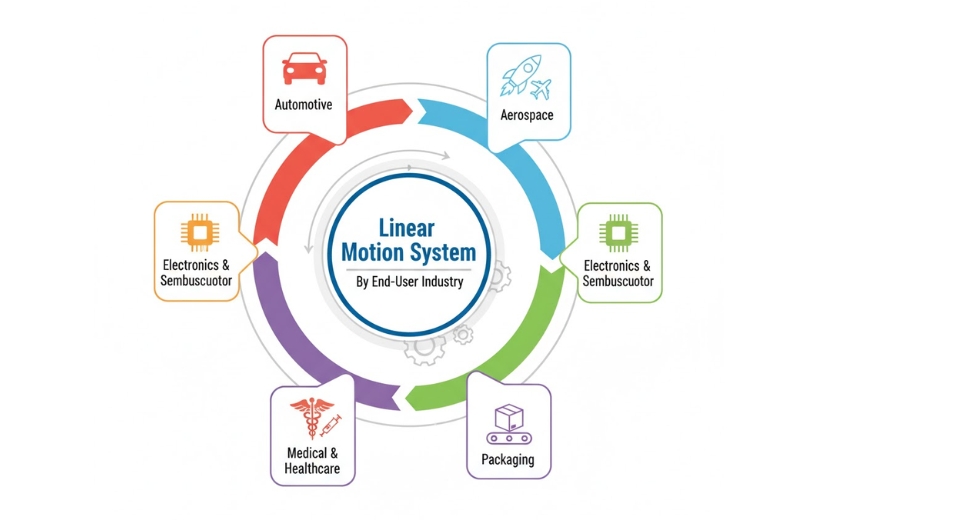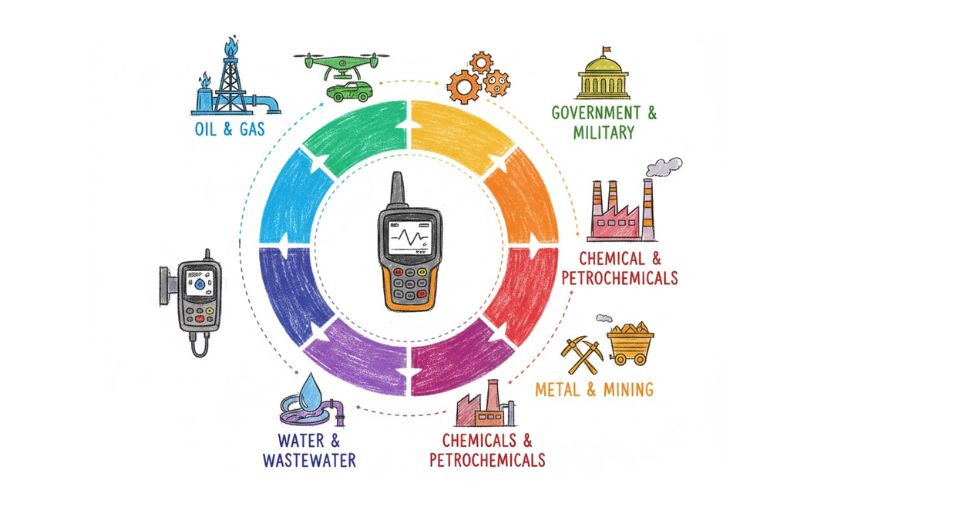MARKET OVERVIEW
The Global Hour Meter market is a niche in the instrumentation sector, specializing in devices that are intended to measure and record the hours of operation of machines, vehicles, and other equipment. This market plays a very important role in manufacturing, construction, agriculture, transportation, and aviation industries where the usage time of machines has to be tracked with precision for maintenance scheduling, efficiency monitoring, and cost management. Hour meters are indispensable tools for ensuring the reliability and longevity of equipment, which in turn allows businesses to optimize their operational performance, reduce downtime, and minimize maintenance costs.
The Global Hour Meter market is comprised of various products that suit different applications and environments. Such devices may range from simple analog counters to sophisticated digital systems equipped with features such as data logging, wireless connectivity, and integration with broader management systems. Although analog hour meters are still an effective tool for basic usage tracking, digital hour meters are becoming more popular because they are accurate, versatile, and can be interfaced with IoT platforms. The trend thus marks the adaptation of the industry towards technological advancement and higher demand for intelligent solutions.
An important characteristic of the Global Hour Meter market is the widespread application of hour meters across various industries. For example, in agriculture, these devices track the operating hours of tractors and harvesters, ensuring that maintenance is carried out in good time to avoid operational hiccups during critical periods. In the construction sector, hour meters help track the usage of heavy machinery like excavators and cranes, contributing to effective resource allocation and cost control. In the industrial and manufacturing arena, these tools are used to monitor equipment like generators and compressors for safety in operations and service schedule compliance.
Another aspect of the Global Hour Meter market is its adaptability to environmental and industry needs. Harsh environment hour meters are rugged and weatherproof, as well as vibration resistant, to withstand extreme conditions, while precision industries, like aviation, rely on advanced systems that maintain exact information of operational data for safety and efficiency.
Thus, the transformations expected in the Global Hour Meter market in the future will be mainly technology-driven. The integration of Internet of Things capabilities will enable real-time monitoring and data analysis to predict potential failure and thereby avoid unexpected breakdowns. More usage of wireless hour meters will become common and transmit data wirelessly for compatibility with remote monitoring systems. The scope of the market is further expanded in line with worldwide sustainability goals as in energy efficiency and material usages.
The Global Hour Meter market will continue to address the increasing demand for efficient machinery management across industries in the years to come. Hour meters will play a central role in optimizing productivity and reducing costs for businesses around the world through critical insights into operational time and performance. Evolution of the market will be aligned closely with technological advancement and shifting industry demands, thus making it more important within the instrumentation landscape.
Global Hour Meter market is estimated to reach $2,783.32 Million by 2031; growing at a CAGR of 5.2% from 2024 to 2031.

GROWTH FACTORS
The Global Hour Meter market has potential growth in the coming years due to several factors that reflect its use in a wide array of applications. Hour meters are valuable instruments used for measuring and recording the operating time of machinery and equipment. With industries progressively emphasizing efficiency and maintenance, the demand for these devices is going to be steady in the coming years. These meters play a very important role in ensuring operational reliability by helping businesses plan timely maintenance and reduce the likelihood of unexpected downtime, which can result in costly repairs and losses.
The primary growth factor driving the Global Hour Meter market is the increasing focus on industrial automation. Companies across the world are integrating advanced monitoring systems into their operations to enhance productivity. Hour meters, as an integral part of such systems, are witnessing a rising demand in sectors such as manufacturing, construction, and agriculture. Additionally, the increasing focus on sustainability and resource optimization further supports the expansion of this market because hour meters help in tracking energy usage and improving equipment efficiency.
The growth of connected devices and Internet of Things (IoT) also contributes significantly to the growth of this market. The advanced features, such as remote monitoring and data analytics, of smart hour meters are gaining popularity. These innovations provide valuable insights into equipment performance, enabling businesses to make informed decisions and optimize their operations. As technology advances, the integration of such features is likely to become a standard expectation, further boosting the demand for hour meters.
However, some factors might pose challenges to the growth of the market. Advanced hour meters have a high initial cost, and the integration process with existing systems is complicated, which might deter small businesses from adopting it. Economic fluctuations and availability of low-cost alternatives may also limit market penetration in price-sensitive regions.
Despite all these challenges, the Global Hour Meter market has some promising opportunities. As industries embark on digital transformation, the call for solutions which easily integrate with smart systems becomes urgent. Another important factor creating an ideal playing ground for innovations is the upsurge interest in predictive maintenance driven by downtime and operational costs. Manufacturers prioritizing user-friendly designs and low cost will win such opportunities ahead of others in years to come. In conclusion, the Global Hour Meter market will also prosper with developments in technology and the demand of the industrial sector towards its adoption. This market will sustain growth if adeptly managed through the potential challenges associated with it.
MARKET SEGMENTATION
By Product Type
In the coming years, the Global Hour Meter market will experience much more development based on technological advances and the demand for efficient tracking and monitoring in a vast number of industries. An hour meter is one of the devices that must measure and record hours of work to ensure correct machinery maintenance, thereby leading to better overall productivity. By 2024, market segmentation has divided the three types of products – AC Hour Meter, DC Hour Meter, and Hybrid Hour Meter – with values estimated at USD 764.40 million, USD 658.19 million, and USD 528.51 million respectively.
The prime reason for rising adoption of AC hour meters is mainly due to extensive usage in industries where alternating current systems are common. These meters have earned their importance through reliability and their ability to perform without failures in challenging situations. DC hour meters, conversely, found an application within direct current-based industry applications, renewable energy installation areas, and car-related industries. Growth in valuation can be perceived through the above scenario, wherein it will represent growing applicability toward sustainable solutions of energy along with electric automobiles. Hybrid hour meters bring together the advantages of both AC and DC systems, providing a flexible solution for the changing requirements of modern machinery.
As the industries focus more on efficiency and maintenance, the demand for hour meters is going to increase. These devices do not only provide the tracking of machine usage but also play an important role in preventing equipment failure by providing data in time for maintenance schedules. With advancements in digital technology, future hour meters may incorporate features like wireless connectivity and integration with cloud-based systems. These innovations will enable real-time monitoring and data analysis, offering users deeper insights into machine performance and longevity.
A further growth factor in the world market is increasing automation across industries, where the measurement of the number of hours for business operations is necessary for streamlining workflows. Applications are spreading from manufacturing to agriculture, driven by the competitive need for more precise monitoring tools. This growth marks a more general trend: smarter and more interconnected systems-towards which foundational hour meters are a part.
In conclusion, the Global Hour Meter market is expected to take a huge stride in evolution as it will be shaped by advancements in technology and the increasing importance of efficiency. AC, DC, and hybrid hour meters will continue to serve diverse industry needs and thus will become an important catalyst for innovation and sustainability.
By Display
The Global Hour Meter market is poised for significant growth with increasing demand from various industries to be accurately monitored and tracked in the usage of equipment. Hour meters are indispensable devices that measure machine, engine, or equipment running hours, thus allowing users to perform maintenance, optimize efficiency, and avoid unnecessary downtime. The importance of such meters lies in manufacturing, construction, agriculture, and healthcare, where efficient, reliable functioning of equipment is crucial.
The market is witnessing innovations in technology that cater to the diverse needs of industries. On the basis of display type, the hour meter market is segmented into Electromechanical, Liquid Crystal Display (LCD), and Light Emitting Diode (LED). Electromechanical hour meters are known for their durability and simple functionality and remain widely used in various applications. However, with greater demands on increasing visibility and precision, higher-technology displays, such as LCD and LED hour meters, are gaining ground. LCD hour meters are highly valued for their readable clarity and power efficiency. Their LED counterpart enjoys a reputation for being bright and of long lifespan for harsh applications requiring maximum visibility.
The future of the **Global Hour Meter market** is reinforced by the rise of digital technology. Wireless and sensor-filled smart hour meters have become a prime area to focus on. These solutions enable remote monitoring and real-time data transmission, optimizing the usage of equipment and allowing business ideas to be taken forward based on data. As industries are moving towards automation and IoT-based solutions, the level of adoption of such intelligent devices would surge forward.
Another reason for market trends is environmental concern. Manufacturers are now designing more energy-efficient and environment-friendly hour meters, which comply with global sustainability goals. In addition, the shift towards renewable sources of energy continues to open up new opportunities; in fact, hour meters find significant use in wind turbines, solar equipment, and other green technologies, where it enables efficient performance monitoring and maintenance requirements.
In line with the needs of the market, as well as the enhancement of productivity and operational cost cuts across industries, the **Global Hour Meter market** is on its way to expand further. The future scope of this market will be a hotbed for innovation and growth as display technologies advance, become more digitalized, and become increasingly focused on sustainability.
By Type
The global hour meter market is projected to grow highly in the future. Hour meters measure the total time of operation for machinery or equipment and are highly relevant in automotive, construction, and agricultural sectors. With increased technological advancements, hour meters are enabling businesses to monitor the use of their equipment more accurately and efficiently, hence optimizing performance and reducing downtime.
This significant division for market segmentation is the type of hour meters used; that is to say, predominantly, these comprise digital and analog meters. Digital hour meters are fast picking up because they provide accuracy in operation and are not a hassle to use. These meters offer higher precision in tracking operating hours, and often, they come with features such as memory storage, automatic data logging, and easy integration with other systems. Digital hour meters will continue to dominate the market because they offer better readability and more advanced functionalities, such as the ability to interface with remote monitoring systems. This trend shows the increasing automation and data-driven decision-making that is being increasingly adopted in several industries.
On the other hand, analog hour meters, although not as feature-rich as their digital counterparts, still have a large market share. These meters are reliable, easy to install, and generally less expensive than digital meters. Although their usage is expected to decrease in favor of digital solutions, analog hour meters will continue to be used in certain markets where basic functionality is all that is needed.
In the coming future, this would lead to higher demands for digital as well as analog hour meters across industries all around the globe to adapt towards better efficient and more cost-effective machineries handling practices. They would find accurate monitoring tools increasing the reliability of the life as well as the performance of equipment. As industries are upgrading their technologies, the advanced hour meters will gain increasing application and be more in demand, especially in industries that call for higher precision and integration with contemporary monitoring systems.
Technology advances will continue to drive the global hour meter market, with digital meters leading the charge because of their superior performance. However, analog meters will remain relevant in applications where simple and straightforward measurement is all that’s required. With the continued development of industries, so too will the role of hour meters in ensuring more efficient operations across various sectors.
By End-Use Industry
The Global Hour Meter market is significant in the sense that it helps track the hours of operation of machinery and equipment used in different industries. With the growth and diversification of industries, the need for hour meters to monitor usage and maintenance schedules becomes more pronounced. This can be understood by focusing on the end-use industries and how this market adjusts to the needs of each sector. The key industries, such as oil and gas, food and beverages, energy, aerospace and defense, electronics and consumer goods, chemicals, and others, will have hour meters with unique applications that promote operational efficiency.
For example, in the oil and gas industry, hour meters will continue to be a vital tool for monitoring the performance of drilling equipment, pumps, and compressors. This is because accurate tracking is essential in this field to ensure that equipment is running efficiently, downtime is reduced, and maintenance schedules can be planned. In the future, automation and digital technologies are likely to become part of hour meters in this industry, allowing for real-time data collection and predictive maintenance.
The food and beverages industry will maintain its dependency on hour meters with respect to machineries including mixers, packaging lines, and refrigeration units. Devices such as these ensure that time limits for working machinery are complied with. Thereby, a production target, as well as quality control issues, can be met in time. In the future, when IoT and smart systems come about, more effective improvements can also be expected to remote monitor and to analyze data collected to optimize the uptime of machine.
In the energy sector, hour meters will become very important monitoring equipment for things like turbines, generators, and pumps to run for long hours efficiently. These meters will come in handy for tracking the number of operational hours of renewable sources of energy, such as wind and solar power systems, especially as energy production becomes more decentralized and sustainable. With time, digital sensors and cloud technologies will be incorporated, and this will provide the operators with real-time insights into the energy production and management process.
Another heavily reliant field would be aerospace and defense for their use in measuring the aircraft engine performance and those of other machines used on ground support. Here, they are bound to put much value into the precise nature and accuracy required of these hour meters in such operations and increasingly as requirements grow towards ensuring greater safety and reliability. They are also more likely to operate as an automatic component within an entire system with this being utilized in gathering the required information that aids maintenance checks.
Hour meters will play a very crucial role in managing the life cycle of high-demand equipment, such as assembly lines and electronics manufacturing devices, in electronics and consumer goods. As the world becomes increasingly interconnected, future hour meters will likely integrate with other systems to provide more holistic usage data to help optimize performance.
Last but not least, the chemical industry will continue to use hour meters to monitor the usage of machinery used in chemical processing, mixing, and packaging. There is a possibility of smart meters that can provide real-time insights into operational efficiency, which could prevent equipment failure and reduce maintenance costs.
The Global Hour Meter market will continue to grow and expand, where each end-use industry will develop its type of requirements and technologies. Since the industries start to become more dependent on automation and digital technologies, the role of hour meters will change into much smarter and efficient systems.
|
Forecast Period |
2024-2031 |
|
Market Size in 2024 |
$1,951.10 million |
|
Market Size by 2031 |
$2,783.32 Million |
|
Growth Rate from 2024 to 2031 |
5.2% |
|
Base Year |
2022 |
|
Regions Covered |
North America, Europe, Asia-Pacific Green, South America, Middle East & Africa |
REGIONAL ANALYSIS
The Global Hour Meter market is experiencing rapid growth in all regions, with each region showing different trends and developments. North America, which comprises the United States, Canada, and Mexico, has been a major player in the market due to its strong industrial base and technological advancements. The demand for hour meters in this region is driven by sectors like automotive, construction, and industrial machinery. North America is going to lead the market in the future due to innovations in smart technologies and automation, where both sectors heavily depend on accurate machine hour monitoring for optimal performance and maintenance schedule.
Europe, including the UK, Germany, France, and Italy, has also established a robust presence in the Global Hour Meter market. This region's growth is mainly due to its advanced manufacturing sectors and high demand for machinery and equipment across the industries. With the European countries now focusing on sustainability and green friendly machinery, the importance of the hour meters on enhancing operational efficiency and reducing energy consumption would be even greater. With the growth in the demand of greener technology products in Europe, the accurate, real-time, and immediate hours from the meters shall surge higher demands for new product developments or further improvement on meter devices collecting hours.
Industrial expansion is rising more rapidly within countries like China, India, Japan, and South Korea of Asia-Pacific regions and hence these economies will prove an important growth geography for Global Hour Meter Market. These economies, especially in the manufacturing and construction sectors, are expected to keep growing, leading to increased demands for hour meters to ensure efficient machine management. With China and India promoting infrastructure development and technology, the prospects for the Asia-Pacific hour meter market are quite bright. The region has a growing interest in automation and smart solutions and is likely to introduce more high-end hour meters that can better serve the more industrialized markets.
South America, including countries such as Brazil and Argentina, is an emerging market for hour meters. There are likely to be more demands on hour meters for machinery and equipment as industrial development increases in the regions. Similarly, the various economies of Middle East & Africa, including those of the GCC countries, Egypt, and South Africa, would also contribute toward the growth in the global market. These regions will become crucial for the development of infrastructure and industries; hour meters will necessarily be used to improve the efficiency and longevity of machinery. Continued industrialization and the usage of smart technologies in these regions are indicative of the steady growth of demands for hour meters in the coming years.

COMPETITIVE PLAYERS
The Global Hour Meter market has had great developments over the past years due to a strong demand in terms of accurate and reliable monitoring of the use of equipment for most industries. The hour meter helps track operational time for machines, vehicles, and devices; therefore, their use allows maintenance to be planned in advance and correct usage ensures optimal efficiency. As industries of the world go through change and evolution, hour meter solutions only grow more refined and innovative, with the integration of smart technology, making it ready for an interesting future for its manufacturers and its consumers.
Ametek Inc., Vehicle Controls LLC, Carlo Gavazzi, Eaton Corporation, Schneider Electric, and Texas Instruments Incorporated are some of the key companies that will make the future of the Global Hour Meter market. These companies are leading the way in the market by developing cutting-edge solutions that meet the demands of a diverse set of sectors such as automobile, industrial machinery, construction, and agriculture. Their products are designed to offer enhanced durability, efficiency, and ease of use, all while maintaining a high level of accuracy in measuring operational time.
In addition to these prominent players, companies like Darshinal Electromation, Linor Technology, Inc., Honeywell International Inc., and Kubler Group have also contributed to the growth of the hour meter market. Their innovative designs aim to enhance the user experience with features such as digital displays, remote monitoring, and integration with cloud-based platforms. These companies are poised to meet the increasing demand for automation and connected devices as demand for advanced hour meters that can provide real-time insights into equipment performance grows.
ABB, SIMEX, Trumeter Technologies Ltd, Panasonic Corporation, ENM Company, and Robert Bosch GmbH are also important contributors to the growth of the market. These companies have a global presence and years of experience in developing electronic solutions for various industries. Their hour meters are designed to withstand harsh environments and offer exceptional accuracy, making them ideal for applications ranging from heavy machinery to consumer electronics.
Automotive business giant VDO Instruments remains keen on developing a more modern approach in making vehicle and machine hour meters. Their drive to build hour meters not only ensures betterment for this specific sector, but it helps contribute to the growth of the entire market, particularly due to precision and durability the company places value on.
The Global Hour Meter market will experience a high demand in the future, as industries embrace smart technologies and automation. The world is shifting towards more connected and data-driven solutions, and hour meters will play a vital role in ensuring that equipment operates efficiently with minimal downtime.
Hour Meter Market Key Segments:
By Product Type
- AC Hour Meter
- DC Hour Meter
- Hybrid Hour Meter
By Display
- Electromechanical
- Liquid Crystal Display (LCD)
- Light Emitting Diode (LED)
By Type
- Digital
- Analog
By End-Use Industry
- Oil & Gas
- Food & Beverages
- Energy
- Aerospace & Defense
- Electronics & Consumer Goods
- Chemicals
- Other
Key Global Hour Meter Industry Players
- Ametek Inc.
- Vehicle Controls LLC
- Carlo Gavazzi
- Eaton Corporation
- Schneider Electric
- Texas Instruments Incorporated
- Darshinal Electromation
- Linor Technology, Inc
- Honeywell International Inc.
- Kubler Group
- ABB
- SIMEX
- Trumeter Technologies Ltd
- Panasonic Corporation
- ENM Company
- Robert Bosch GmbH
- VDO Instruments
WHAT REPORT PROVIDES
- Full in-depth analysis of the parent Industry
- Important changes in market and its dynamics
- Segmentation details of the market
- Former, on-going, and projected market analysis in terms of volume and value
- Assessment of niche industry developments
- Market share analysis
- Key strategies of major players
- Emerging segments and regional growth potential







 US: +1 3023308252
US: +1 3023308252






